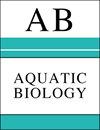Aggressive interactions between the invasive anemone Anemonia alicemartinae and the native anemone Phymactis papillosa
IF 0.8
4区 生物学
Q3 MARINE & FRESHWATER BIOLOGY
引用次数: 3
Abstract
The distribution range expansion of species mediated by natural or anthropic mechanisms is one of the main causes of changes in biodiversity patterns. Anemonia alicemartinae is a cryptogenic species found along the coasts of the Southeast Pacific Ocean. This species has ex panded its range by >1900 km along the Chilean coast throughout the last 50 yr. A. alicemartinae co habits with the native anemone Phymactis papillosa in the low intertidal zone, and given the limited mobility of both species, limited space could encourage aggressive behavior between them. P. papillosa shows different color phenotypes, and, as in other anemone species, color is associated with its level of aggressiveness. Here, we evaluated the aggressive behavior of A. alicemartinae on 2 color morphotypes of P. papillosa. Also, intraspecific agonistic interactions were considered in individuals of A. alicemartinae from 2 localities. Four experiments were conducted: (1) individual vs. individual, (2) individual vs. group forming a frontal line, (3) individual vs. group surrounding the individual and (4) group vs. group. Results showed A. alicemartinae to be a weak competitor against P. papillosa. The cryptogenic species lost more contests with green P. papillosa than with the red phenotype. Few aggressive interactions between conspecifics of A. alicemartinae were found. Results suggest that the expansion success of A. alicemartinae could be explained by alternative strategies, such as escape behavior, asexual reproduction and high dispersal potential.入侵海葵(Anemonia alicemartinae)与本地海葵(Phymactis papillosa)的攻击相互作用
自然或人为机制介导的物种分布范围扩大是生物多样性格局变化的主要原因之一。Anemonia alicemartinae是东南太平洋沿岸发现的一种隐生物种。在过去的50年里,这一物种沿着智利海岸扩大了超过1900公里的活动范围。在低潮间带,A. alicemartinae与本地海葵Phymactis papillosa共同生活,由于这两种物种的流动性有限,有限的空间可能会鼓励它们之间的攻击行为。凤头海葵表现出不同的颜色表型,并且,在其他海葵物种中,颜色与它的攻击性水平有关。本研究对两种颜色形态的乳头状假蝇进行了攻击行为评价。此外,我们还研究了来自两个地区的金针菇个体的种内激动相互作用。实验分为四个部分:(1)个体对个体,(2)个体对群体形成前沿,(3)个体对个体周围的群体,(4)群体对群体。结果表明,金银花对金银花的竞争能力较弱。隐基因种在与绿色型的竞争中比在与红色型的竞争中落败更多。同种异种间的攻击性相互作用较少。结果表明,野田葵的扩张成功可能与逃避行为、无性繁殖和高传播潜力等多种策略有关。
本文章由计算机程序翻译,如有差异,请以英文原文为准。
求助全文
约1分钟内获得全文
求助全文
来源期刊

Aquatic Biology
生物-海洋与淡水生物学
CiteScore
2.70
自引率
0.00%
发文量
7
审稿时长
3 months
期刊介绍:
AB publishes rigorously refereed and carefully selected Feature Articles, Research Articles, Reviews and Notes, as well as Comments/Reply Comments (for details see MEPS 228:1), Theme Sections, Opinion Pieces (previously called ''As I See It'') (for details consult the Guidelines for Authors) concerned with the biology, physiology, biochemistry and genetics (including the ’omics‘) of all aquatic organisms under laboratory and field conditions, and at all levels of organisation and investigation. Areas covered include:
-Biological aspects of biota: Evolution and speciation; life histories; biodiversity, biogeography and phylogeography; population genetics; biological connectedness between marine and freshwater biota; paleobiology of aquatic environments; invasive species.
-Biochemical and physiological aspects of aquatic life; synthesis and conversion of organic matter (mechanisms of auto- and heterotrophy, digestion, respiration, nutrition); thermo-, ion, osmo- and volume-regulation; stress and stress resistance; metabolism and energy budgets; non-genetic and genetic adaptation.
-Species interactions: Environment–organism and organism–organism interrelationships; predation: defenses (physical and chemical); symbioses.
-Molecular biology of aquatic life.
-Behavior: Orientation in space and time; migrations; feeding and reproductive behavior; agonistic behavior.
-Toxicology and water-quality effects on organisms; anthropogenic impacts on aquatic biota (e.g. pollution, fisheries); stream regulation and restoration.
-Theoretical biology: mathematical modelling of biological processes and species interactions.
-Methodology and equipment employed in aquatic biological research; underwater exploration and experimentation.
-Exploitation of aquatic biota: Fisheries; cultivation of aquatic organisms: use, management, protection and conservation of living aquatic resources.
-Reproduction and development in marine, brackish and freshwater organisms
 求助内容:
求助内容: 应助结果提醒方式:
应助结果提醒方式:


